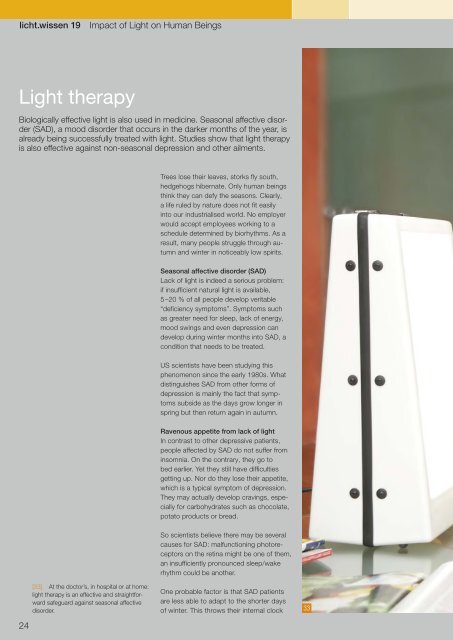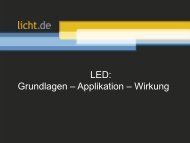licht.wissen 19 No. "Impact of Light on Human Beings"
Light synchronises our “internal clock”. Lighting that copies daylight has more than just a visual impact; it supports bodily functions 24 hours a day. Booklet 19 is intended for all those who want to delve into the topic of Impact of Light on Human Beings. The 56 pages helps to get an overview of what melanopic light can effect. Free Download at www.licht.de/en
Light synchronises our “internal clock”. Lighting that copies daylight has more than just a visual impact; it supports bodily functions 24 hours a day. Booklet 19 is intended for all those who want to delve into the topic of Impact of Light on Human Beings. The 56 pages helps to get an overview of what melanopic light can effect. Free Download at www.licht.de/en
Create successful ePaper yourself
Turn your PDF publications into a flip-book with our unique Google optimized e-Paper software.
<str<strong>on</strong>g>licht</str<strong>on</strong>g>.<str<strong>on</strong>g>wissen</str<strong>on</strong>g> <str<strong>on</strong>g>19</str<strong>on</strong>g><br />
<str<strong>on</strong>g>Impact</str<strong>on</strong>g> <str<strong>on</strong>g>of</str<strong>on</strong>g> <str<strong>on</strong>g>Light</str<strong>on</strong>g> <strong>on</strong> <strong>Human</strong> Beings<br />
<str<strong>on</strong>g>Light</str<strong>on</strong>g> therapy<br />
Biologically effective light is also used in medicine. Seas<strong>on</strong>al affective disorder<br />
(SAD), a mood disorder that occurs in the darker m<strong>on</strong>ths <str<strong>on</strong>g>of</str<strong>on</strong>g> the year, is<br />
already being successfully treated with light. Studies show that light therapy<br />
is also effective against n<strong>on</strong>-seas<strong>on</strong>al depressi<strong>on</strong> and other ailments.<br />
Trees lose their leaves, storks fly south,<br />
hedgehogs hibernate. Only human beings<br />
think they can defy the seas<strong>on</strong>s. Clearly,<br />
a life ruled by nature does not fit easily<br />
into our industrialised world. <str<strong>on</strong>g>No</str<strong>on</strong>g> employer<br />
would accept employees working to a<br />
schedule determined by biorhythms. As a<br />
result, many people struggle through autumn<br />
and winter in noticeably low spirits.<br />
Seas<strong>on</strong>al affective disorder (SAD)<br />
Lack <str<strong>on</strong>g>of</str<strong>on</strong>g> light is indeed a serious problem:<br />
if insufficient natural light is available,<br />
5–20 % <str<strong>on</strong>g>of</str<strong>on</strong>g> all people develop veritable<br />
“deficiency symptoms”. Symptoms such<br />
as greater need for sleep, lack <str<strong>on</strong>g>of</str<strong>on</strong>g> energy,<br />
mood swings and even depressi<strong>on</strong> can<br />
develop during winter m<strong>on</strong>ths into SAD, a<br />
c<strong>on</strong>diti<strong>on</strong> that needs to be treated.<br />
US scientists have been studying this<br />
phenomen<strong>on</strong> since the early <str<strong>on</strong>g>19</str<strong>on</strong>g>80s. What<br />
distinguishes SAD from other forms <str<strong>on</strong>g>of</str<strong>on</strong>g><br />
depressi<strong>on</strong> is mainly the fact that symptoms<br />
subside as the days grow l<strong>on</strong>ger in<br />
spring but then return again in autumn.<br />
Ravenous appetite from lack <str<strong>on</strong>g>of</str<strong>on</strong>g> light<br />
In c<strong>on</strong>trast to other depressive patients,<br />
people affected by SAD do not suffer from<br />
insomnia. On the c<strong>on</strong>trary, they go to<br />
bed earlier. Yet they still have difficulties<br />
getting up. <str<strong>on</strong>g>No</str<strong>on</strong>g>r do they lose their appetite,<br />
which is a typical symptom <str<strong>on</strong>g>of</str<strong>on</strong>g> depressi<strong>on</strong>.<br />
They may actually develop cravings, especially<br />
for carbohydrates such as chocolate,<br />
potato products or bread.<br />
24<br />
So scientists believe there may be several<br />
causes for SAD: malfuncti<strong>on</strong>ing photoreceptors<br />
<strong>on</strong> the retina might be <strong>on</strong>e <str<strong>on</strong>g>of</str<strong>on</strong>g> them,<br />
an insufficiently pr<strong>on</strong>ounced sleep/wake<br />
rhythm could be another.<br />
[33] At the doctor’s, in hospital or at home:<br />
light therapy is an effective and straightforward<br />
safeguard against seas<strong>on</strong>al affective are less able to adapt to the shorter days<br />
One probable factor is that SAD patients<br />
disorder. <str<strong>on</strong>g>of</str<strong>on</strong>g> winter. This throws their internal clock 33

















